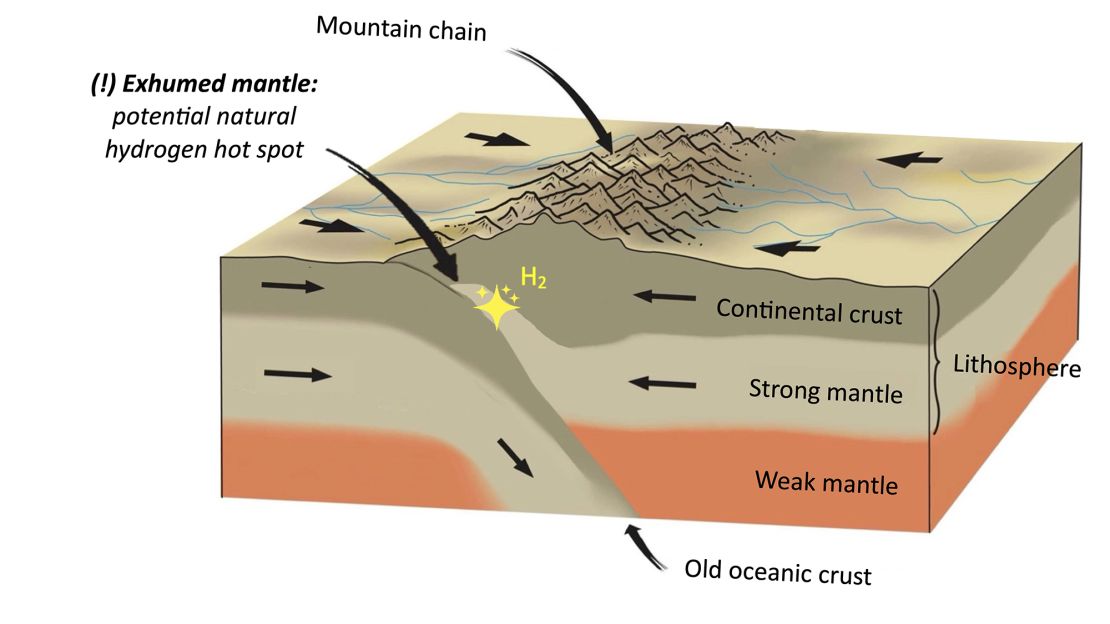White hydrogen has recently gained attention for its potential to help replace planet-heating fossil fuels. It was only a couple of decades ago that some scientists started saying this powerful fuel — also called “natural” or “geologic” hydrogen — existed within the Earth’s crust in large amounts.
Since then, geologists have pored over how it forms and where it might be located. The main problem has been working out where to find volumes large enough to be useful for humanity’s insatiable energy appetite.
To find answers, a team of scientists used computer models to simulate the movement of the planet’s tectonic plates and pinpoint regions where the right conditions exist for generating white hydrogen. They found mountain ranges such as the Pyrenees and the European Alps are potential hotspots, according to the study published Wednesday in the journal Science Advances.
Hydrogen, which produces only water when burned, has long been eyed as a green fuel, especially for energy-hungry industries like aviation and steel-making. But most commercial hydrogen is produced using fossil fuels, defeating its climate-saving powers.
That’s why white hydrogen is such a tantalizing prospect.
Interest can arguably be traced back to the accidental discovery of white hydrogen in Mali in 1987 when a water well exploded as a worker leaned over the edge with a cigarette. The well was swiftly covered but was unplugged in 2011 and has since been producing hydrogen to help power a local village.
White hydrogen has been found in the US, Australia, and France, among other places, but the issue has been finding large amounts.
“We have known that nature produces hydrogen, but it has never really been explored as an option for energy production,” said Frank Zwaan, a study author and geologist at the Helmholtz Centre for Geosciences in Germany. Other energy sources were easier to access, he said, but the escalating climate crisis is amping up the race to find alternatives.
The gas forms naturally through many processes, including radioactive decay in the crust. But Zwaan’s team focused on “serpentinization,” where water interacts with iron-rich rocks from the Earth’s mantle to produce hydrogen.
These rocks are normally deep within the Earth where water isn’t readily available, but geological processes over millions of years can push them toward the surface. It happens under the oceans as continents break apart allowing mantle rocks to rise, and also when continents collide, closing ocean basins and forcing mantle rocks upward.

The scientists use tectonic plate modeling to determine where and when this mantle rock was “exhumed” and in what quantities, Zwaan said.
They found certain mountain ranges, including the Pyrenees, the European Alps, and parts of the Himalayas, offered good conditions for generating white hydrogen as large volumes of mantle rock were present at favorable temperatures, and deep faults allowed water to circulate.
The quantities of mantle rock available to serpentize in mountain ranges alone suggest white hydrogen “could be a game changer,” Zwaan said.
Geoffrey Ellis, a geochemist with the US Geological Survey, who was not involved in the research, said the processes which bring mantle rocks close to the surface are already well known. What’s novel about this study, he told CNN, is that it “provides quantitative approach” for assessing the white hydrogen potential of different settings where mantle rocks have been lifted.
The big question now will be finding where the white hydrogen accumulates in large reservoirs that can drilled, Zwaan said. It may also be possible to artificially stimulate serpentization by drilling areas where mantle rocks are close to the surface and pumping in water, he added.
Early exploration is already happening in areas including France, the Balkans and the US.
This new research can help guide geologists to regions with the greatest potential for large-scale white hydrogen resources and will likely have “a direct and substantial impact on geologic hydrogen exploration,” said Ellis.
There are many steps to creating a viable white hydrogen industry, including developing reliable, economic methods to extract it and infrastructure to store and transport it. It will likely take decades to commercialize, Zwaan said. “We should not expect it to be an instant miracle cure.”
But, he is optimistic. “Oil was somewhat of a curiosity until the technique was ready for it to be applied on a large scale,” he said, white hydrogen “may follow a similar pathway.”














